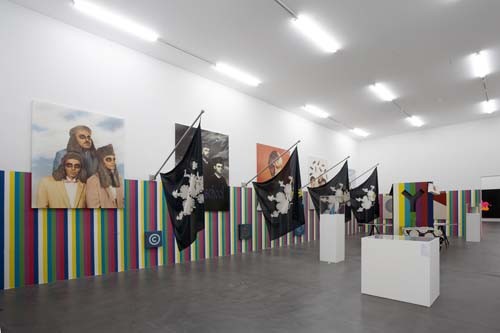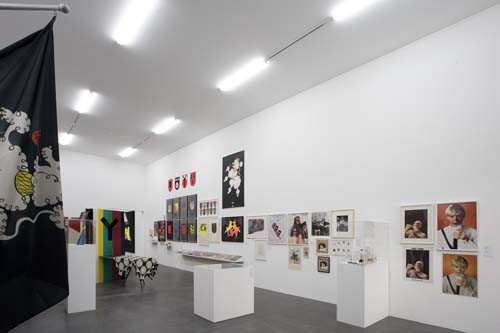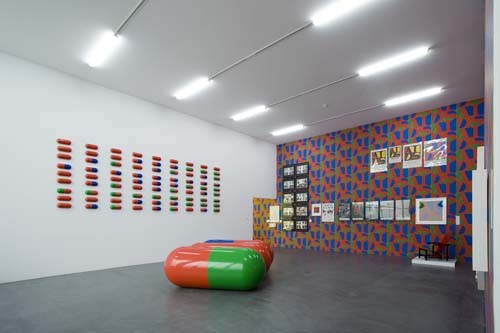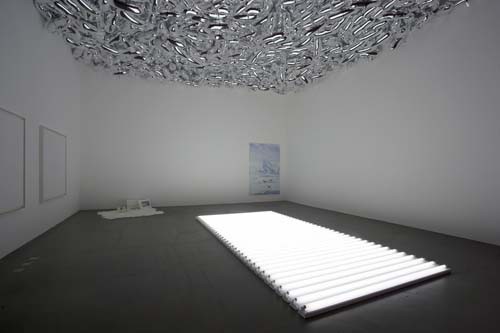General Idea
11 Nov 2006 - 07 Jan 2007
GENERAL IDEA: FOUND FORMATS
with the travelling exhibition
GENERAL IDEA EDITIONS 1967–1995, curated by Barbara Fischer
11 NOVEMBER 2006 – 7 JANUARY 2007
“ We entered history, seized hold of images, emptied them of meaning, and reduced them to shells. Then we filled the shells with glamour, the creamy puff-pastry innocence of vacuity, the awful silence of shark fins cutting through oily water.” (General Idea)
Kunsthalle Zurich presents the oeuvre of Canadian artists group General Idea (AA Bronson, Felix Partz†, Jorge Zontal†) for the first time since their 1992 show Fin de Siecle in Stuttgart’s Kunstverein and their last exhibition in Switzerland, in 1984 at Kunsthalle Basel in the biggest comprehensive overview of their work to be assembled and seen in Europe to date.
In addition to key installations and central pieces by the artists group GENERAL IDEA: FOUND FORMATS covers the travelling exhibition GENERAL IDEA EDITIONS 1967-1995 as compiled by Barbara Fischer and AA Bronson and bringing together over 300 works from the fields of editions and multiples. Following its successful tour of ten venues in Canada, the United States and Germany, the retrospective on the editions now forms the chronological backbone of the show at Kunsthalle Zurich, which is being organised in close cooperation with AA Bronson.
General Idea was founded in Toronto in 1969 by AA Bronson, Felix Partz and Jorge Zontal. According to AA Bronson, General Idea arose “in the aftermath of the Paris student unrest, from the remainders of the hippie communes, the underground newspapers, radical teaching, happenings, love-ins, Marshall McLuhan and the Situationist International. We believed in a free economy, in the abolition of copyright and in horizontal grass-roots structures that pre-empted the architecture of the Internet.” Felix Partz and Jorge Zontal both died of AIDS in 1994.
With its theoretically precise interventions and humorous and formally accurate use of found formats from the context of art as well as the media and consumer society as of the early 1970s, the group attracted international attention.
General Idea’s oeuvre features a broad range of media, including installations, sculptures, performances, photographs, pieces on canvas, videos and drawings as well as – from the very outset and in keeping with the conceptual art-political thrust of their work - integrally and of equal stance the design and production of magazines, unlimited editions, mail art, multiples, editions, postcards, posters, and even wallpaper, T-shirts, balloons, coats of arms and tableware.
The group’s subversive appropriations of works and formats from high and popular culture and their radical treatment of the idea of the collective, with autonomous distribution forms that ran against the customary modes of dissemination and marketing for their own work and that of other artists were truly trailblazing. They pre-empted in exemplary fashion issues from art production in the 1980s, 1990s and of the current generation of artists. In 1974, the collective founded the Art Metropole store in Toronto, which to this day produces and distributes editions and books by artists.
General Idea’s critical enquiry into the relationship of art and the media, art and the market, and art and AIDS are pioneering for aesthetic debate today and are highly topical precisely for the latest generation of artists. This relates to their formulations as regards questions of identity and copyright, their praxis of collective and autonomous modes of working and living, and the conceptual foundations for their works, the strategies of “viral infections” and parasitical appropriations of media and formats from art history and popular culture – themes that have shaped precisely the very young generation, whose perception and experience of reality and of tackling issues of identity and original, of approaching and using “images”has been decisively influenced by the Internet.
General Idea’s artistic interventions in the 1980s and 1990s, which amounted to a social debate on AIDS in numerous works, media and actions in public space, were exemplary for a form of political activism that succeeds in formal and artistic terms.
GENERAL IDEA: FOUND FORMATS extends the works of editions of multiples found in all areas of the group’s oeuvre from 1967 through 1995 to include central pieces and installations from their 30 years of creative output. The FILE Megazine launched in 1972 which was for a while forbidden owing to its intelligent transformation of the style and content of LIFE-Magazine will be on view in its entirety; the renowned AIDS-Wallpaper (a transformation of Gary Indiana’s piece LOVE) will also be on view as will be the Triniton wallpaper, reminiscent of a TV test image, as the background for paintings and sculptures that the artists “found” in the formats of art and media history: for example the complete set of self-portraits by the artists group – which ever since 1982 have appeared in constantly new versions in the form of poodles, babies, doctors and in the Fin de Siecle installation (1992) as their final doubles as seals in an icy setting. Borrowing from Warhol’s Silver Clouds the installation with balloons Magic Bullet (1991) and Magic Carpet (1992), the latter featuring fluorescent lamps and reformulating Dan Flavin as a carpet of light are equally on view. Likewise showcased are the Miss General Idea Pavillon, the Placebo pieces from the 1990s that highlight AIDS medication, the Yen Boutique (1991) and the 10-part series of images on Mondo Cane Kama Sutra (1984).
with the travelling exhibition
GENERAL IDEA EDITIONS 1967–1995, curated by Barbara Fischer
11 NOVEMBER 2006 – 7 JANUARY 2007
“ We entered history, seized hold of images, emptied them of meaning, and reduced them to shells. Then we filled the shells with glamour, the creamy puff-pastry innocence of vacuity, the awful silence of shark fins cutting through oily water.” (General Idea)
Kunsthalle Zurich presents the oeuvre of Canadian artists group General Idea (AA Bronson, Felix Partz†, Jorge Zontal†) for the first time since their 1992 show Fin de Siecle in Stuttgart’s Kunstverein and their last exhibition in Switzerland, in 1984 at Kunsthalle Basel in the biggest comprehensive overview of their work to be assembled and seen in Europe to date.
In addition to key installations and central pieces by the artists group GENERAL IDEA: FOUND FORMATS covers the travelling exhibition GENERAL IDEA EDITIONS 1967-1995 as compiled by Barbara Fischer and AA Bronson and bringing together over 300 works from the fields of editions and multiples. Following its successful tour of ten venues in Canada, the United States and Germany, the retrospective on the editions now forms the chronological backbone of the show at Kunsthalle Zurich, which is being organised in close cooperation with AA Bronson.
General Idea was founded in Toronto in 1969 by AA Bronson, Felix Partz and Jorge Zontal. According to AA Bronson, General Idea arose “in the aftermath of the Paris student unrest, from the remainders of the hippie communes, the underground newspapers, radical teaching, happenings, love-ins, Marshall McLuhan and the Situationist International. We believed in a free economy, in the abolition of copyright and in horizontal grass-roots structures that pre-empted the architecture of the Internet.” Felix Partz and Jorge Zontal both died of AIDS in 1994.
With its theoretically precise interventions and humorous and formally accurate use of found formats from the context of art as well as the media and consumer society as of the early 1970s, the group attracted international attention.
General Idea’s oeuvre features a broad range of media, including installations, sculptures, performances, photographs, pieces on canvas, videos and drawings as well as – from the very outset and in keeping with the conceptual art-political thrust of their work - integrally and of equal stance the design and production of magazines, unlimited editions, mail art, multiples, editions, postcards, posters, and even wallpaper, T-shirts, balloons, coats of arms and tableware.
The group’s subversive appropriations of works and formats from high and popular culture and their radical treatment of the idea of the collective, with autonomous distribution forms that ran against the customary modes of dissemination and marketing for their own work and that of other artists were truly trailblazing. They pre-empted in exemplary fashion issues from art production in the 1980s, 1990s and of the current generation of artists. In 1974, the collective founded the Art Metropole store in Toronto, which to this day produces and distributes editions and books by artists.
General Idea’s critical enquiry into the relationship of art and the media, art and the market, and art and AIDS are pioneering for aesthetic debate today and are highly topical precisely for the latest generation of artists. This relates to their formulations as regards questions of identity and copyright, their praxis of collective and autonomous modes of working and living, and the conceptual foundations for their works, the strategies of “viral infections” and parasitical appropriations of media and formats from art history and popular culture – themes that have shaped precisely the very young generation, whose perception and experience of reality and of tackling issues of identity and original, of approaching and using “images”has been decisively influenced by the Internet.
General Idea’s artistic interventions in the 1980s and 1990s, which amounted to a social debate on AIDS in numerous works, media and actions in public space, were exemplary for a form of political activism that succeeds in formal and artistic terms.
GENERAL IDEA: FOUND FORMATS extends the works of editions of multiples found in all areas of the group’s oeuvre from 1967 through 1995 to include central pieces and installations from their 30 years of creative output. The FILE Megazine launched in 1972 which was for a while forbidden owing to its intelligent transformation of the style and content of LIFE-Magazine will be on view in its entirety; the renowned AIDS-Wallpaper (a transformation of Gary Indiana’s piece LOVE) will also be on view as will be the Triniton wallpaper, reminiscent of a TV test image, as the background for paintings and sculptures that the artists “found” in the formats of art and media history: for example the complete set of self-portraits by the artists group – which ever since 1982 have appeared in constantly new versions in the form of poodles, babies, doctors and in the Fin de Siecle installation (1992) as their final doubles as seals in an icy setting. Borrowing from Warhol’s Silver Clouds the installation with balloons Magic Bullet (1991) and Magic Carpet (1992), the latter featuring fluorescent lamps and reformulating Dan Flavin as a carpet of light are equally on view. Likewise showcased are the Miss General Idea Pavillon, the Placebo pieces from the 1990s that highlight AIDS medication, the Yen Boutique (1991) and the 10-part series of images on Mondo Cane Kama Sutra (1984).





